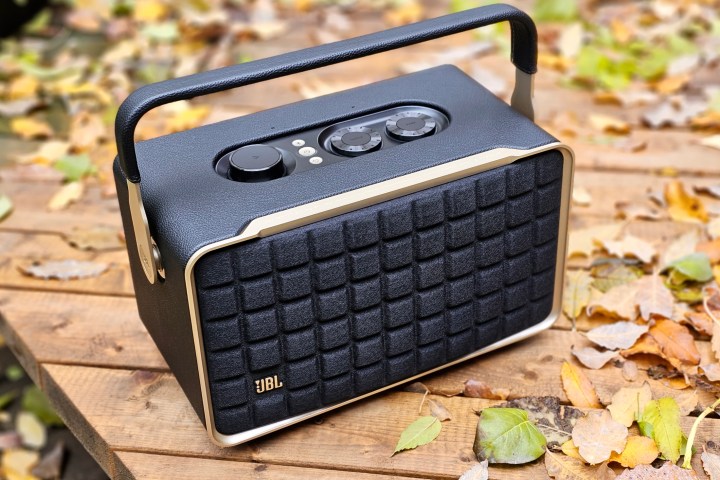
You’ve probably seen a million Bluetooth speakers online and in stores. Hyperbole aside, that’s no surprise, as Bluetooth is one of the most convenient wireless standards. But when it comes to overall sound quality, it's hard to beat the performance and versatility you’ll get with a Wi-Fi-connected speaker. And while Sonos was one of the first brands to leverage your home network for its wireless speaker lineup, web-connected speakers are now available from numerous speaker brands.
What exactly can a Wi-Fi speaker do that a regular ole’ Bluetooth speaker can’t? For starters, Bluetooth has both quality and distance limits. You’ll be hard-pressed to get your phone and Bluetooth speaker shaking hands when you’re more than 35 feet away. In most cases, a web-connected speaker will be paired with your Wi-Fi, which basically eliminates that distance caveat (a typical Wi-Fi connection can reach up to 115 feet indoors). The higher bandwidth also allows for streaming of higher-quality music tracks for better sound.
Many Wi-Fi speakers also include far more inputs and outputs than a traditional Bluetooth model. At the same time, some even have built-in interfaces for popular music-streaming platforms like Spotify and Tidal.
We see a lot of wireless speakers in our line of work, so we put together this list of all our favorite 2024 options to help make your shopping a little easier. For this roundup, we're going to focus more on the plug-in variety with Wi-Fi and/or Bluetooth wireless capabilities. So, without further ado, here’s our roundup of the best wireless speakers.



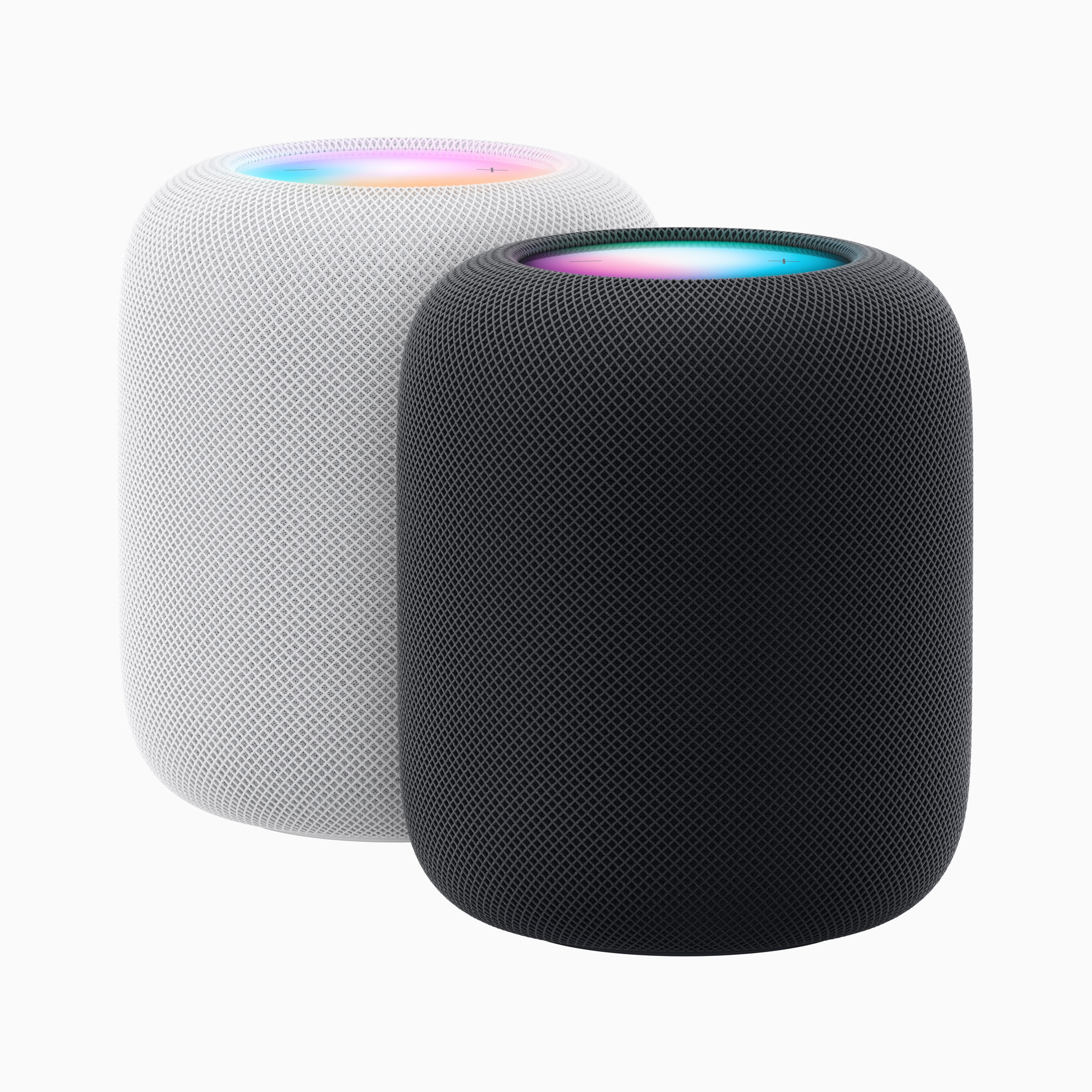






The best wireless speaker for most people
Sonos Era 100
- Big, expansive sound
- Bluetooth now built-in
- Optional analog line-in
- Super-easy room tuning
- No Google Assistant option
Out with the old and in with the new, they say, and the now-discontinued Sonos One, the tried-and-true wireless network speaker that has sat at the top of this list for ages, couldn't have asked for a more worthy successor than the Sonos Era 100. Launched early this year, the Era 100 is everything that the One was and more. A powerful, compact network speaker with unsurprisingly excellent sound (this is Sonos, after all), the Era 100 is many people's entry into Sonos' whole-home audio system and is just as at home solo in the kitchen (voice control makes it perfect while cooking) as it is stereo paired with another Era or even as rear surrounds in a home theater Sonos configuration.
A bit taller and more cylindrical than the One, there are a bunch of reasons to go for the Era 100 over the One (while they last), least of which is that it's just $30 more, so why wouldn't you? First and foremost is the sound. Newly configured tweeters are angled creating what our reviewer, Simon Cohen, praised as an "impressive sense of openness" and " expansive soundstage." A bigger woofer in the Era 100 also gives it a decidedly bigger punch, and if filling a small-to-medium-sized room is your goal, few wireless speakers of this size and budget do it better than this. Add to that Sonos' fantastic Truplay tuning, adjustable EQ , and AirPlay 2 compatibility and what more could you want?
The Era 100 also benefits from Sonos' experience with one of the best user-interface apps on the market, giving you access to all of your streaming services — hi-res ones, too, as because it's a Wi-Fi speaker you can capitalize on all that beautiful lossless sound. But fear not, the Era 100 does Bluetooth, too, allowing you and other users to connect to it without going through the Wi-Fi connection and send Bluetooth-connected music through your Sonos system's grouped speakers, as well. The Era 100 also has a line-in connector should you want to hook up a turntable or other external source to the speaker (and also send out to the whole system).
The only thing missing from the Era 100 is Google Assistant voice control. Thanks to a legal dispute between Sonos and Google, the popular voice assistant has been absent from all new Sonos speakers starting with the Era 100 and Era 300, and those that have come since, including Move 2 and Roam 2 speakers. For now, users will have to settle for Alexa and Sonos' own voice assistant, which ain't bad either.
Easy as heck to setup and use, for how the Era 100 sounds and the price, this wireless speaker is hard to beat. All Sonos has to do is clear up the disaster that has been made of the Sonos app, and hopefully the company will return to its former glory.

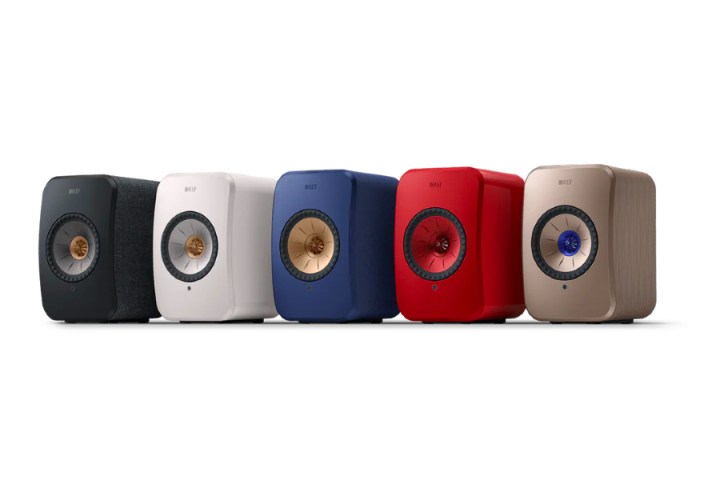
The best premium wireless bookshelf speakers
KEF LSX II
- Big and clear KEF sound
- Wi-Fi, Ethernet, and Bluetooth connectivity
- HDMI ARC, USB-C, 3.5mm, TOSLINK inputs
- Compact design
- Expensive
- Cheaper than the KEF LS50
The first generation of KEF's superb LSX wireless hi-fi speakers were on this list for some time, and we've found no reason to take them off — but we have updated our choice with the improved second generation, the KEF LSX II.
We made the comparison to the popular and premium KEF LS50 Wireless II, which are still among the best-sounding bookshelves you can buy for the money, and their wireless convenience makes them among our favorite speakers we've encountered. And KEF's LSX II still offer much of what's to like about the KEF LS50 Wireless for less than half the price.
The KEF LSX II stick with their tradition of offering sound that's big, crystal clear, and expressive, with a wide soundstage that defies what should be capable from speakers so small. But that's KEF for you.
Wi-Fi and Bluetooth wireless connectivity is only the start with the LSX II, with the second gen improving the speakers' connection stability with its W2 technology. The optical 3.5 mm AUX, subwoofer out, and Ethernet connection options are now joined by USB-C and HDMI ARC in the LSX II. It is also now compatible with a whole bunch of third-party services including Apple AirPlay 2, Google Chromecast, Amazon Music, Qobuz, Tidal, and Spotify Connect. DSD and MQA audio codec support is on tap too, for audiophiles who want to hear the best digital sound possible.
The KEF LSX II benefit from KEF's proprietary Uni-Q speaker driver tech that sets the tweeter in the middle of an 11-inch woofer for what KEF says is a more natural sound. The LSX II are available in five colors: Carbon Black, Mineral White, Cobalt Blue, Lava Red, and Soundwave.
And another thing: if the hefty $1,300 price of the LSX II is a bit hard for your to swallow, in an effort to make its products more accessible, the company recently launched the $1,000 LEX II LT, a slightly pared-down version.


Ideal for Spotify and Tidal subscribers
Edifier MS50A Wi-Fi Smart Speaker
- Warm, bass-driven sound profile
- Classy design
- Supports Wi-Fi and Bluetooth
- Native integrations for Spotify and Tidal
- No EQ options in the Edifier app
- Missing a microphone (no hands-free Alexa or speaker phone)
Edifier is an AV brand we’re always glad to spotlight, and it just so happens that the Edifier MS50A Wi-Fi Smart Speaker sounds pretty phenomenal. At 6 inches wide, 8 inches tall, and 6 inches from front to back, this is one of the larger Wi-Fi speakers on the market, so you’ll want to make sure you have enough tabletop or shelf space. And like many other products on this list, this Edifier speaker needs to be plugged into an AC outlet.
As far as sound quality goes, the Edifier MS50A is a beast. Expect warm and punchy low-end and crystalline higher frequencies, thanks to the onboard 15-watt tweeter. At max volume, the Edifier should output up to 40 watts.
You’ll need to download the Edifier Home app to get this speaker connected to your network, but you’ll definitely want to hang onto this companion app after setup. Edifier’s software is where you’ll go for firmware updates, playback controls (the top of the speaker features manual controls), and a few other settings.
One of our favorite features of this speaker is its native integration of Spotify and Tidal Connect. This means you won’t need to rely on your phone for streaming Wi-Fi music on either platform. The Edifier can also be controlled with Alexa, but because the speaker doesn’t have a built-in mic, you’ll need your phone or an Alexa smart speaker to do so.

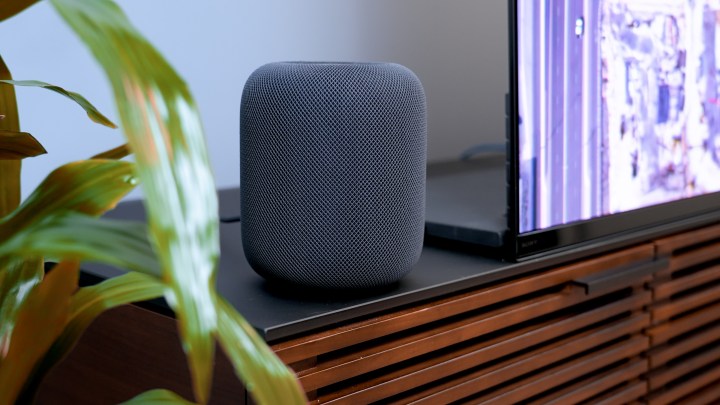
Best wireless speaker for Apple fans
Apple HomePod (2nd Gen)
- Great sound quality
- Incredible bass performance
- Dazzling Spatial Audio surround
- Plug and Play wireless
- Slick design
- Limited connection options
- No direct Spotify playback
No one really knows why Apple discontinued the first generation of the HomePod, but the point becomes moot when the comeback version of this wireless speaker is so great, especially if you're a user of Apple products.
While on the surface, the second-gen HomePod doesn't look much different than its predecessor, things have gotten markedly better on the inside (and my mom always said that's what counts). Driven by Apple's advanced S7 processor, the HomePod 2 pulls off a ton of cool "computational audio" features, like automatically sensing the room and its position in it (it knows when it's in a corner or jammed between books on a shelf), and adjusting its sound accordingly.
This is also great for maximizing sound for Apple's Spatial Audio, which sounds great in one HomePod, but even better when pairing two HomePods together (they must be the same model and generation) and connecting them to an Apple TV 4K. This setup can be a great solution if you're also looking to bring better sound to your TV and home theater experience, but don't worry, if music is your main thing ,the HomePod (single or stereo pair) sounds great and supports Apple Music's Dolby Atmos and Spatial Audio tracks, too.
Delivering this big sound in such a small package is a big 20mm woofer and five beamforming tweeters, which our own Caleb Denison vouches for in his review, describing the bass as "full-bodied, present, and punchy," and the midrange as "lush, full-bodied, and clear, if not a bit forward in the mix, especially with vocals."
Apple fans will love the HomePod for its deep integration with the Apple ecosystem, but others might find that frustrating — Apple Music is the only music service supported natively, and the only voice assistant available is Siri, for example. But the HomePod is dead simple to set up (like most of Apple's products) and is a competent smart speaker that, with full compatibility with the Matter standard, works seamlessly with HomeKit and other smart home accessories. It even has new built-in temperature and humidity sensors for automating smart thermostats and blinds, for example, and it can listen for smoke alarms and carbon monoxide alarms to alert you when you're out of the house. Not bad for a $300 wireless speaker.

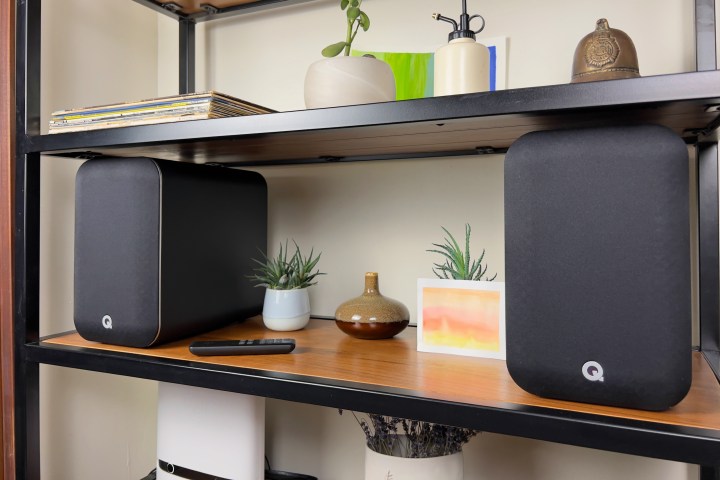
Best mid-range desktop speakers with inputs galore
Q Acoustics M20 HD Powered Wireless Music System
- Clear, refined sound with any music
- Wide soundstage in any room
- Versatility of placement
- Tons of connectivity options
- aptX HD Bluetooth
- A bit big for desktops
- Better with a subwoofer
As music lovers are mixing and matching technologies and formats spanning analog and digital to create their unique perfect audio solutions, we're seeing components and speakers that are making old things new and new things play nice with old things, too. One such set of speakers is the Q Acoustics M20 HD Wireless Music System, which is essentially a set of very good-sounding Bluetooth bookshelf speakers that refuses to stay in its lane by offering a ton of connections and audio tech so they can be used, well, almost any way you like.
In my review of the Q Acoustics M20s, I put them everywhere I could — on my office desk, in my dining room on a bookshelf, with my vinyl record collection, with my TV — using its wide range of inputs including RCA, optical TOSLINK, USB, 3.5mm AUX, and aptX HD Bluetooth for high-resolution streaming at 24-bit/48kHz. True to its name, this set of speakers can be a true wireless music system that you can connect to turntables, DVD players, CD players, computers, TVs, smartphones, and more.
Some innovative digital processing also does a great job of adapting the M20s to those setup locations. Whether they're in a corner, against a wall, or out in the open, there's a toggle switch on the back that lets you tell the speakers where they are so they can adjust. You can even designate the left and right orientation of the main powered speaker and its connected pair to make for easier access to controls on the back and the location of power outlets.
While they don't stand toe-to-toe with the premium KEF LSX II on our list, they sound great and are a good value at $600.


Best for Dolby Atmos Music
Sonos Era 300
- Dolby Atmos Music-compatible
- Incredible, immersive sound
- Easy, fast room tuning
- Perfect as home theater surrounds
- Line-in for analog sources
- Bluetooth, AirPlay 2
- No Google Assistant
Don't be fooled by the Sonos Era 300's weird hourglass shape, it's all part of Sonos' design to let five of the speakers' six drivers do what they do best — shoot incredible Dolby Atmos music outwards and upwards for an immersive spatial audio sound experience. The effect, if you've yet to explore it on a service such as Amazon Music Unlimited or Apple Music, is, well, I'll let Simon Cohen explain from his review: "It places you within the music, letting a band tell a subtly different story with their voices and instruments by adjusting how you relate to them beyond a simple left-right presentation."
The under-appreciated music format is getting its due with the Era 300, to be sure, but that's not the only reason to go for the Era 300; it's a Sonos and it sounds fantastic no matter what music you throw at it. And to jump back to surround sound for just a second, if you're looking to build out a Sonos-based home theater setup, adding a pair of Era 300s as rear surrounds with a Sonos Arc or Beam (2nd gen) is a home theater setup that can easily compete with a full AV receiver-based system.
Sound aside, the Era 300 enjoys all the spoils of Sonos — it's easy to set up, and apart from the (hopefully temporary) issues Sonos has been having with the redesign of the Sonos app, its easy to use. And because it's a Wi-Fi speaker, you get to tap into all that hi-res lossless audio that Bluetooth just can't handle yet.
But if Bluetooth is a big deal to you, the Era 300 and its smaller sibling the Era 100 are the first home-based Sonos speakers to offer Bluetooth connectivity as well. And you can use them in tandem — if a friend wants to connect over Bluetooth to the Sonos system and share their best Spotify playlist, they can do so and send it to any speaker in the system.
Touch controls on the top of the Era 300 are intuitive and fun to use, letting you slide a finger across a grooved slider to adjust volume. Pause/play, track skip, and mic mute function are there, too, and there's even a physical mic kill switch on the back of the speaker. Also on the back is the Era 300's USB-C line-in port that, with the addition of a Sonos line-in adapter, lets you connect an external sound source like a turntable if you want to share your vinyl through your system.
The Era 300 is also a smart speaker, with access to Alexa and its own Sonos Voice Control (SVC), but currently there is no access to Google Assistant. Hopefully this will change in the future, but for now, no GA for Era 300 or 100. But that shouldn't be a deal breaker, as the Era 300 is easily the best speaker the company has ever made.


The best portable Sonos speaker
Sonos Roam 2
- Balanced, articulate sound quality
- Effective room calibration tools
- Has a dedicated Bluetooth button
- IP67 rated
- Battery life is just OK
- No Google Assistant support
While Sonos didn’t aim to reinvent the wheel with the release of the Sonos Roam 2 (so little was changed that it only warranted a mini-review of the speaker), what we did get was a handful of meaningful tweaks to the original Roam’s design. Available in Black, White, Olive, Wave, and Sunset colorways, the Roam 2 is one of the only Sonos speakers that doesn’t require AC power. On a full charge, the built-in battery should last for up to five hours, though you’ll also be able to operate the speaker while it’s plugged in for a recharge.
Compared to the previous generation, the newer Roam speaker includes a dedicated Bluetooth button. This makes it easy to switch over to the Bluetooth input in a pinch, but the Roam 2 also works over a Wi-Fi connection. In terms of sound quality, you can expect a decent-sized soundstage with admiral treatment paid to the midrange. The Sonos app has a built-in EQ you’ll be able to mess around with, which bodes well for those of us who need a little more bass in our songs.
Unfortunately, the Roam 2 doesn’t support Google Assistant, but you’ll be able to use Alexa and Sonos’ voice assistant to control playback, smart home devices, and a handful of other things. The speaker is also IP67-rated, which means it’ll hold up nicely against dirt, debris, and moisture.

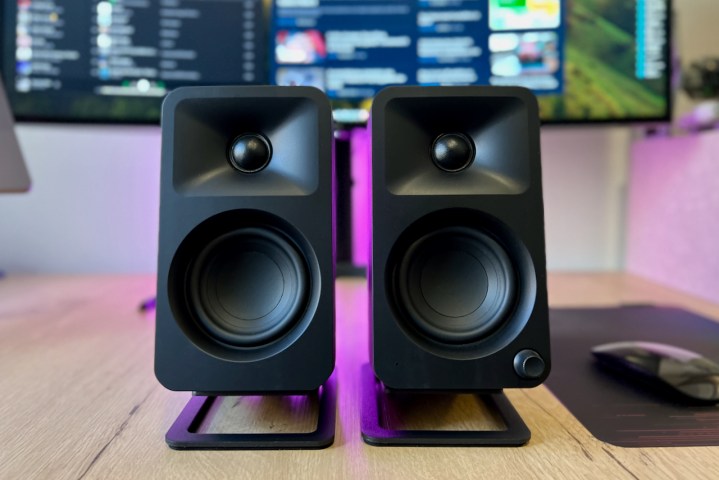
Best wireless desktop reference speakers
Kanto Audio Ora
- Small, discreet footprint
- Impossibly clear reference sound
- Mids and highs that shine
- Killer low-end, especially with a sub
- 100 watts of power
- USB-C and Bluetooth connectivity
- A bit pricey
- No Bluetooth aptX support
- An optical input would be nice
- Doesn't come with cables
Arriving with a very understated design, the Kanto Ora desktop speakers deliver the kind of audio experience we’d expect from much larger drivers. Kanto never ceases to amaze us, and this 100W duo has got what it takes to take your desktop sound to the next level. A big hand in this is Class D amplification, which brings studio-style power and performance to the table. From highs to lows, the Ora handles it all, but are especially impressive when paired with a subwoofer.
The 3-inch woofers do a great job of handling bass all their own, but we found that integrating a sub took some low-end strain off the speakers. Plus, once a sub is connected, the Ora automatically balances the frequencies between the speakers and the dedicated woofer. Connections-wise, you’ll have the choice of USB-C, RCA, and Bluetooth 5.0, along with an LFE output for a separate sub.
We do wish that the Kanto Ora would have come with a couple of cables for our audio devices, and aptX support is sorely missing. But what keeps us coming back to this product is the compact size. Smaller than the average studio monitors, the Ora speakers are easy to incorporate into most desktop workstations, and can even be wall-mounted or placed on speaker stands.


Best sounding speaker with retro cool
JBL Authentics 300
- Unique, retro design
- Easy set up
- Excellent build, top-notch materials
- Intuitive controls
- Powerful sound
- Google Assistant and Amazon Alexa
- Limited battery life
- Bass suffers at low volumes
- Awkward multiroom control
- Chromecast requires Google Assistant
Sometimes a blast from the past is what a wireless speaker needs to be ultra-cool. Such is certainly the case with the JBL Authentics 300, a Wi-Fi speaker with lots of aesthetic charm, on top of awesome sound quality. Before diving into performance, let’s take a closer look at the exterior, which just so happens to combine faux leather, gold trim, and a “Quadrex” grille. On paper, it sounds like a ‘70s throwback, and it would appear that way in person, too!
Device controls are handled by both the JBL One app, as well as some intuitive volume and EQ knobs on the Authentics 300 itself. LED indicator rings respond to master volume and frequency (treble, mids, bass) adjustments. If you plan on taking the speaker on-the-go, there’s even a battery level LED strip to help you keep tabs on how much power remains. On a full charge, you should get about eight hours of playtime.
As far as sound quality goes, the Authentics 300 doesn’t disappoint. Audio is crisp and clear across the board, and there’s a decent amount of bass too. We did notice that you lose some definition when the speaker is set to 50% volume or less though. In terms of playback, we also highly recommend you download the JBL One app (for iOS and Android).
You’ll be able to use JBL One for everything from Wi-Fi connectivity to software updates and multi-room audio controls. Connecting to Wi-Fi also unlocks the ability to use the Authentics 300 as an Alexa or Google Assistant smart speaker.

Frequently Asked Questions
We test wireless speakers the same way you would use a wireless speaker. No fancy measuring equipment, no anechoic chambers, just our ears, the speakers, and some of our favorite music sources. If the speaker is designed to go outside, we take it outside. If it's waterproof, we throw it in a pool or the ocean. If it's a smart speaker, we see how well it responds to our voice commands.
Despite its casual nature, this process is highly comprehensive and includes checking out things you might not have thought about, like range, connection stability, and performance in areas with a lot of radio frequency interference (i.e., the Digital Trends offices).
Finally, we compare each speaker to some of our go-to models, both in their class and price point, as well as a level or two above, to find out if they can punch above their weight.
NFC: Shorthand for Near Field Communication, this oft-touted feature is actually quite limited when it comes to Bluetooth speakers, allowing select phones to pair with a speaker with a quick touch. Since pairing is often as simple as pressing a button, and speakers will be remembered by your device once paired, it’s not seen as a must-have feature.
aptX: Another feature limited to phones and devices outside of Apple’s periphery, aptX is a codec (or group of codecs) that allows Bluetooth streaming at “near CD quality” resolution. Apple products do not use aptX, but Android users may find it improves performance when paired with high-quality tracks and high-performance speakers.
Passive radiator: A passive radiator is a type of driver used to enhance bass in a speaker. In a sealed speaker enclosure (no portholes) a passive radiator responds to fluctuations in air pressure within the enclosure, creating sound. Since a passive radiator doesn’t have to be powered by an amp, it has no magnet or voice coil, and is, therefore, lighter and smaller than a traditional driver. This saves space and cost while increasing the speaker’s performance.
Pairing (or Bluetooth pairing): In the case of Bluetooth speakers, pairing is the act of making a wireless connection from a speaker to your wireless device via Bluetooth.
Stereo pairing: The ability to treat two individual wireless speakers as the left and right speakers of a stereo pair. This is usually accomplished using an app, and the speakers need to be compatible with the stereo pairing function.
Hi-res music: These are audio tracks that have been created from master recordings at much higher levels of detail and range than typical MP3 files. They contain up to four times as much information per song, and when played back through high-quality speakers that support them, they deliver more detail, less overlap between instruments and frequencies, and generally better sound when played at higher volumes. Hi-res music files require Wi-Fi, Bluetooth aptX HD, Sony’s proprietary LDAC wireless codec, or a wired connection from the source to the speaker, so not all wireless speakers are compatible.
Multiroom audio: The ability for a wireless speaker to become part of a centrally controlled, multispeaker whole-home sound system. In these systems, each speaker can play a different source, all speakers can play the same source in perfect sync, or you can combine the two. A good example of a wireless, multiroom audio system would be Sonos.
WiSA: An acronym for “Wireless Sound and Audio,” this standard for wireless audio eliminates excess audio cables for multiroom setups with up to eight speakers. Over 60 popular audio brands, including Klipsch, Bang & Olufsen, and Harman Kardon, offer WiSA products.




![The JBL Xtreme 4 Bluetooth speaker. [Embargoed image 06/03]](https://www.digitaltrends.com/wp-content/uploads/2024/05/jbl-xtreme-4-review-in-water-o2.jpeg?resize=650%2C390&p=1)